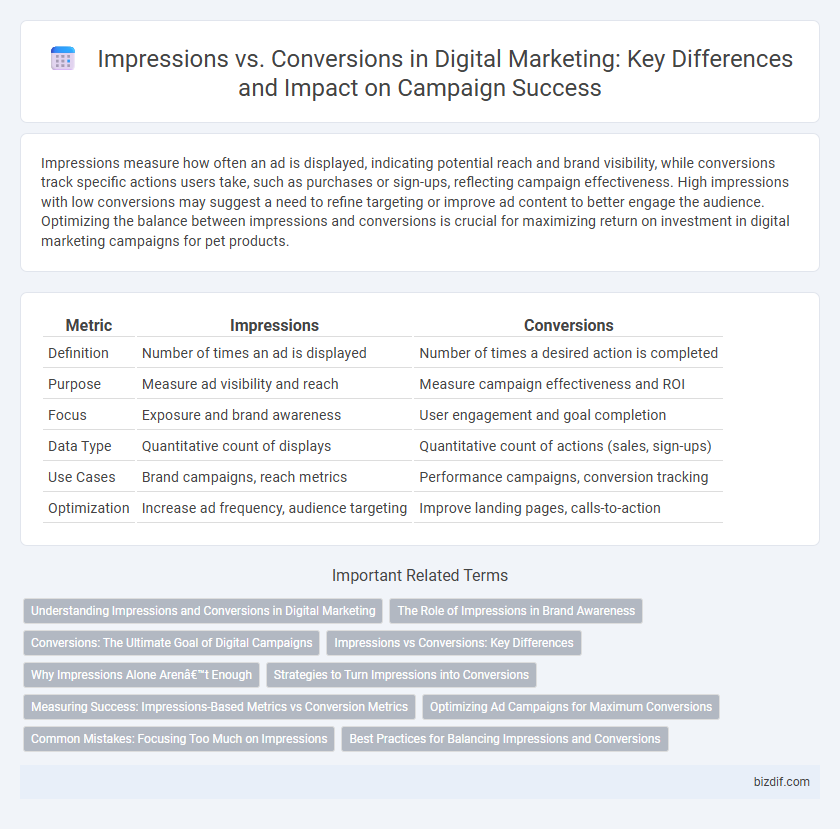Impressions measure how often an ad is displayed, indicating potential reach and brand visibility, while conversions track specific actions users take, such as purchases or sign-ups, reflecting campaign effectiveness. High impressions with low conversions may suggest a need to refine targeting or improve ad content to better engage the audience. Optimizing the balance between impressions and conversions is crucial for maximizing return on investment in digital marketing campaigns for pet products.
Table of Comparison
| Metric | Impressions | Conversions |
|---|---|---|
| Definition | Number of times an ad is displayed | Number of times a desired action is completed |
| Purpose | Measure ad visibility and reach | Measure campaign effectiveness and ROI |
| Focus | Exposure and brand awareness | User engagement and goal completion |
| Data Type | Quantitative count of displays | Quantitative count of actions (sales, sign-ups) |
| Use Cases | Brand campaigns, reach metrics | Performance campaigns, conversion tracking |
| Optimization | Increase ad frequency, audience targeting | Improve landing pages, calls-to-action |
Understanding Impressions and Conversions in Digital Marketing
Impressions in digital marketing represent the total number of times an ad is displayed to users, serving as a key metric for brand visibility and reach. Conversions measure the actions taken by users after interacting with an ad, such as purchases or sign-ups, indicating the effectiveness of the marketing campaign. Analyzing both impressions and conversions enables marketers to optimize ad strategies by balancing awareness with user engagement and return on investment.
The Role of Impressions in Brand Awareness
Impressions play a crucial role in building brand awareness by exposing a large audience to a brand's message, increasing familiarity and recognition over time. While impressions measure how often an ad is viewed, conversions track specific actions like purchases or sign-ups, making impressions essential for the top funnel efforts in digital marketing. High impression volume enhances brand recall, which indirectly supports conversion rates by nurturing trust and interest before customers engage with a campaign.
Conversions: The Ultimate Goal of Digital Campaigns
Conversions represent the definitive success metric in digital marketing campaigns, quantifying the number of users who complete desired actions such as purchases, sign-ups, or downloads. Unlike impressions, which merely track the frequency of ad views, conversions directly measure user engagement and return on investment (ROI). Optimizing campaigns for higher conversion rates involves targeted messaging, personalized content, and seamless user experiences to drive meaningful business outcomes.
Impressions vs Conversions: Key Differences
Impressions represent the total number of times an ad is displayed to users, indicating reach and brand visibility, while conversions measure the actual actions taken by users, such as purchases or sign-ups, reflecting campaign effectiveness and return on investment. Impressions track exposure without guaranteeing engagement, whereas conversions provide concrete evidence of marketing impact through measurable outcomes. Understanding the key differences between impressions and conversions helps optimize digital marketing strategies by balancing brand awareness with actionable results.
Why Impressions Alone Aren’t Enough
Impressions indicate how many times an ad is displayed, but they don't measure user engagement or ROI, making them insufficient for campaign success evaluation. Focusing solely on impressions overlooks the essential conversion metrics that demonstrate actual customer actions and sales. Prioritizing conversions over impressions helps marketers optimize strategies for tangible business growth and higher profitability.
Strategies to Turn Impressions into Conversions
Maximizing conversions from impressions requires targeted strategies such as personalized ad content, precise audience segmentation, and compelling calls-to-action (CTAs). Leveraging data analytics to identify user behavior patterns and optimizing ad placements enhances engagement and drives higher conversion rates. Implementing retargeting campaigns and A/B testing ad creatives further refines the funnel to turn passive impressions into active customer actions.
Measuring Success: Impressions-Based Metrics vs Conversion Metrics
Impressions measure how often an ad is seen, providing insight into brand awareness and reach, while conversions track specific actions like purchases or sign-ups, directly reflecting campaign effectiveness and return on investment (ROI). Relying solely on impressions can overestimate success without context on user engagement, whereas conversion metrics offer a clearer picture of how well marketing efforts drive desired outcomes. Combining both metrics enables a comprehensive evaluation of digital marketing performance, optimizing strategies for both visibility and actionable results.
Optimizing Ad Campaigns for Maximum Conversions
Impressions measure the total number of times an ad is displayed, while conversions track the number of desired actions completed by users, such as purchases or sign-ups. Optimizing ad campaigns for maximum conversions requires analyzing conversion rates rather than just focusing on high impressions to ensure budget efficiency and targeted audience engagement. Utilizing tools like A/B testing, precise audience segmentation, and conversion tracking pixels enhances campaign performance by aligning ad creatives with user intent and behaviors.
Common Mistakes: Focusing Too Much on Impressions
Focusing too much on impressions can mislead digital marketing strategies by emphasizing quantity over quality, often resulting in low conversion rates. Marketers frequently mistake high impressions for campaign success without analyzing if the audience engages or takes desired actions. Prioritizing conversions instead ensures better ROI by targeting and optimizing for user behavior and purchase intent rather than mere visibility.
Best Practices for Balancing Impressions and Conversions
Maximizing digital marketing success requires a strategic balance between impressions and conversions, optimizing ad spend by targeting high-intent audiences to improve conversion rates. Utilizing A/B testing for ad creatives and landing pages refines message resonance, increasing engagement while minimizing wasted impressions. Implementing analytics tools like Google Analytics and conversion tracking enhances data-driven decisions to allocate budget efficiently across channels, prioritizing quality interactions over sheer volume.
Impressions vs conversions Infographic

 bizdif.com
bizdif.com